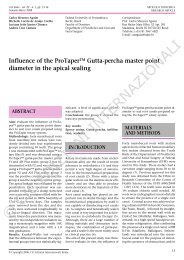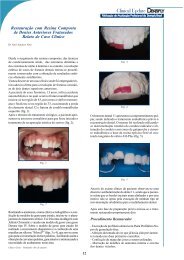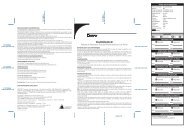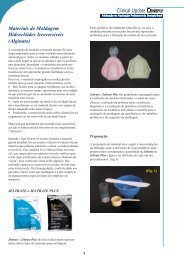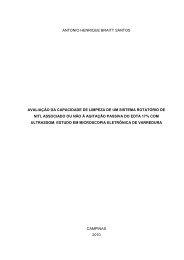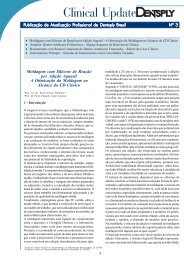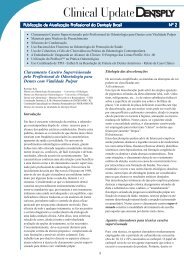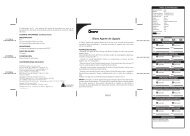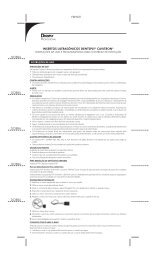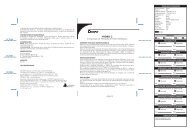Create successful ePaper yourself
Turn your PDF publications into a flip-book with our unique Google optimized e-Paper software.
Blunck/Zaslansky<br />
[% MQ1]<br />
100<br />
95<br />
a.<br />
90<br />
85<br />
Optibond FL<br />
80<br />
75<br />
T1 T2 T3 T4 T5 T6<br />
[% MQ1]<br />
100<br />
95<br />
b.<br />
90<br />
85<br />
Syntac<br />
80<br />
75<br />
T1 T2 T3 T4 T5 T6<br />
c.<br />
[% MQ1]<br />
100<br />
95<br />
90<br />
85<br />
80<br />
75<br />
Clearfil SE Bond<br />
T1 T2 T3 T4 T5 T6<br />
Fig 3 Median MQ1 values in % of entire margin length<br />
in dentin with error bars indicating the standard error of<br />
the mean for the multi-bottle reference materials (a) Opti<br />
Bond FL, (b) Syntac and (c) Clearfil SE Bond at the six<br />
evaluation stages T1 (after 21 days’ water storage), T2<br />
(after 1st TC), T3 (after 1 year of water storage), T4 (after<br />
2nd TC), T5 (after 3 years of water storage) and T6 (after<br />
3rd TC). Black lines: regression lines weighted by the corresponding<br />
standard error; dotted lines: 95% confidence<br />
intervals.<br />
study, but overall the scores are quite high, perhaps due to<br />
the fact that the deterioration is generally quite minimal.<br />
Further examination of the present data allows creating a<br />
quasi-dynamic perspective of the deterioration rate of the<br />
restorations (Fig 3 and Table 3). Thus it is seen that there is<br />
a general negative trend in the MQ1 values, when these are<br />
determined after water storage and/or thermocycling (TC).<br />
Clearly, the specific state of the bond between each<br />
restorative and the tooth is not easily determined by any surface-evaluation<br />
method, particularly following long-term water<br />
storage. The decision was thus made to use TC to induce<br />
mild stress to every tooth-restoration interface in order to better<br />
reveal its state as determined by the marginal quality evaluation.<br />
As can be seen in Table 3, the effect of TC is not constant<br />
during early vs late (> 1 year) water storage, and this is<br />
attributed to the differences in the adhesive stability in water.<br />
A number of publications have dealt with the effects of<br />
similar long-term water storage beyond 2 years. 2,3,7,16,22,<br />
23,27 To the best of our knowledge, however, none have managed<br />
to produce high-resolution long-term data mapping the<br />
marginal quality deterioration on the same samples.<br />
Despite the fact that the cavity dimensions were standardized,<br />
the amount of stress induced to the interface of<br />
each restoration probably varied considerably. This might<br />
be due to the large variations in the coefficients of thermal<br />
expansion of each restorative 28,29 or possibly due to tooth<br />
variability. Be that as it may, because the manufacturer-recommended<br />
composites were used, it was assumed that the<br />
conditions were optimal for each adhesive, and that the<br />
best performance was obtained. It remains to be seen if other<br />
combinations of composite/adhesive deliver improved<br />
long-term results. Possibly, a standard composite restorative<br />
should be used for such tests in the future in order to<br />
better compare the effectiveness of the investigated adhesives.<br />
The importance of the effect of the composite resins<br />
can clearly be seen in the groups of Adper Prompt L-Pop and<br />
Xeno III, where large differences in MQ1 values and slopes<br />
are seen for the same adhesive. Note however, that while<br />
Adper Prompt L-Pop in combination with Tetric Ceram<br />
showed a statistically significant decrease in MQ1 compared<br />
to the results obtained with Filtek Z250, all three<br />
combinations with Xeno III (Dyract XP, Quixfil, and Tetric Ceram)<br />
revealed no statistically significant differences in marginal<br />
integrity. We therefore conclude that these adhesives<br />
react differently to composite resins with higher polymerization<br />
shrinkage stress values.<br />
Both in vitro 6,7,10,11 and in vivo studies 8,12,13,35,37 have<br />
shown that multi-bottle multi-step adhesive systems such as<br />
236 The Journal of Adhesive Dentistry



